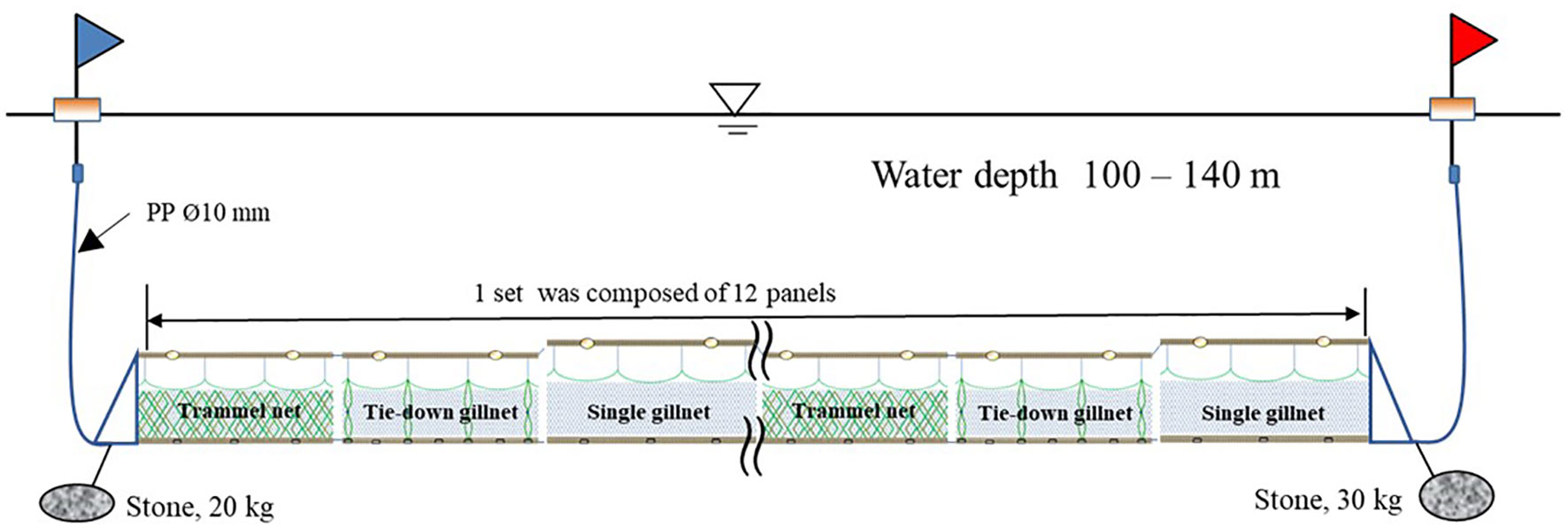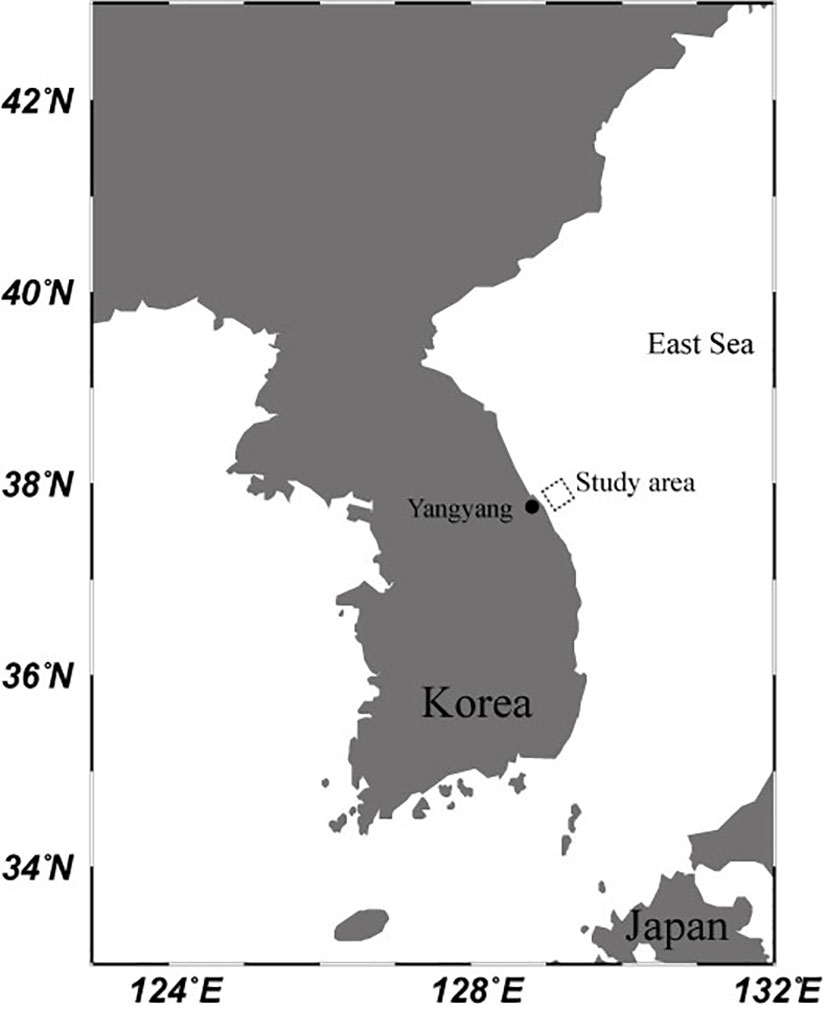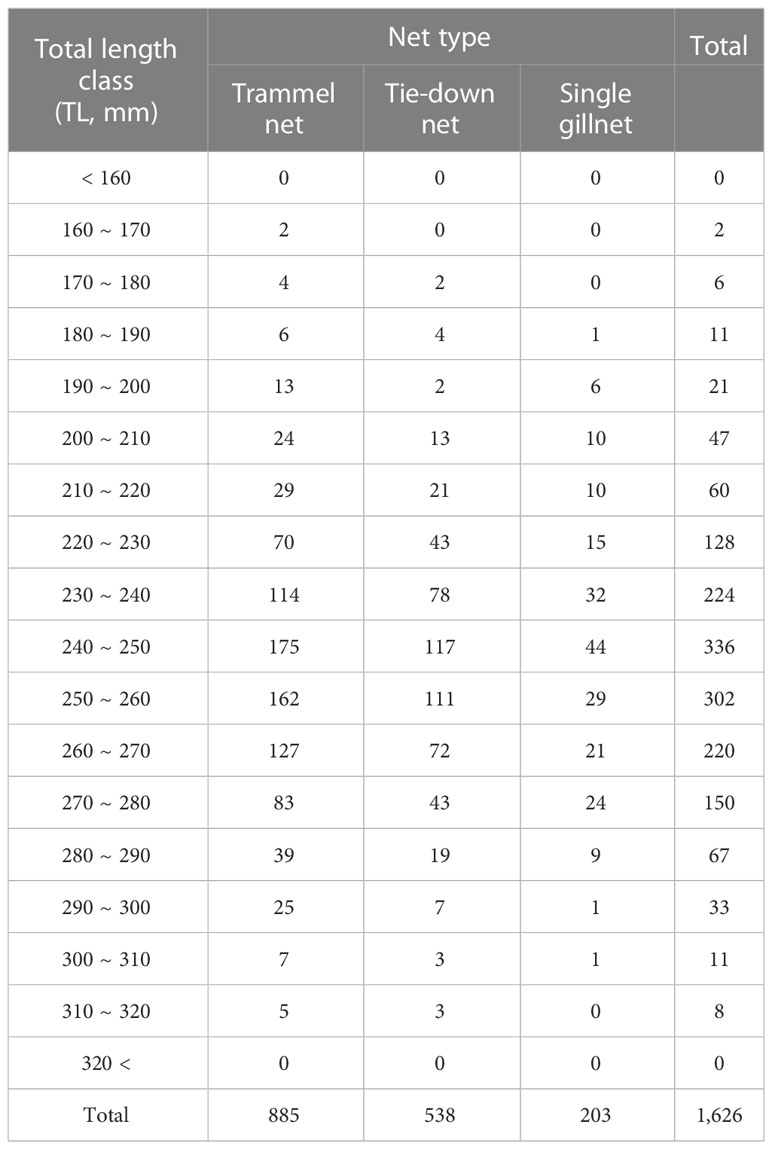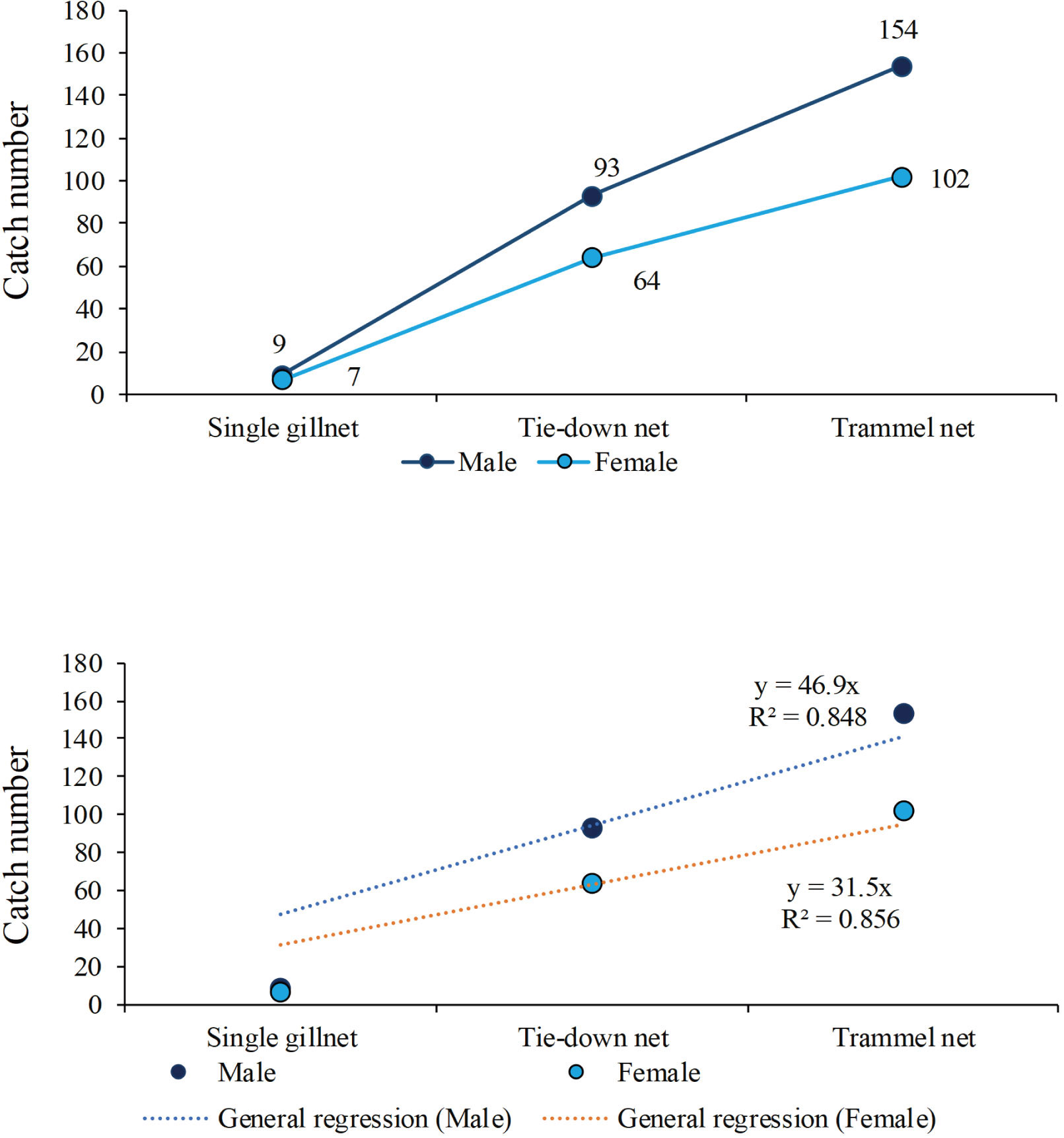- 1Department of Marine Production System Management, Pukyong National University, Busan, Republic of Korea
- 2Division of Fisheries Resources and Environment Research, East Sea Fisheries Research Institute, National Institute of Fisheries Science, Gangneung, Republic of Korea
In this study, experimental fishing trials were performed to quantitatively evaluate and compare the fishing performance of trammel nets, tie-down gillnets, and single gillnets used for catching blackfin flounder. A total of eight cruises performed at depths of 100–140 m in the waters near Yangyang, Gangwon-do, Korea. Fisheries laws in Korea currently restrict the use of trammel nets due to concerns about overfishing and bycatch. Tie-down gillnets have a support line that changes their stretched height, thus increasing their catch rate, and are an attractive alternative to trammel nets or single gillnets; unmodified gillnet. Due to a lack of quantitative evaluation of their fishing performance, the performances of these three types of gillnets quantitatively compared. The number and weight of fish, particularly blackfish flounder, caught by each net under similar circumstances were compared. Our results suggest that the fishing performance of trammel nets and tie-down gillnets is much higher than that of single gillnets. Compared to single gillnets, trammel nets performed better by 2.98 times and 2.45 times, in terms of the total number and weight of fish caught, respectively, and tie-down gillnets performed better by 2.09 times and 1.97 times, respectively. In addition, the bycatch rate of tie-down gillnet for immature blackfin flounder with the total length less than 20 centimeters was similar to single gillnet; single gillnet 17.5% of immature blackfin flounder, tie-down 20% of immature blackfin flounder, trammel net 62.5% of immature blackfin flounder. Given that many flat fish such as flounders fall out of the net during the fishing process after being stuck in single gillnets, fishermen hope to use trammel nets. However, the relatively high catch rate of trammel nets likely necessitates restrictions for their use. This study suggests that tie-down gillnets are an option for sustainable fishing practice given that they perform better than single gillnet and reduce bycatch of immature blackfin flounder when compared to trammel nets.
1 Introduction
The gillnet and trap are commonly practiced fishing gears along the East Sea fisheries of Koera, where gillnets mainly catch snow crab (Chionoecetes opilio), blackfin flounder (Glyptocephalus stelleri), herring (Clupea pallasii), and blackfish (Arctoscopus japonicus), whereas trap fishing mainly catch octopus (Enteroctopus dofleini), sea snails (Buccinum spp.), and red snow crab (Chionoecetes japonicus).
Aside from large fisheries such as trawls, most flounder in this area are caught by gillnets. The annual catch of blackfin flounder (Glyptocephalus stelleri, Figure 1) as of 2020 is 1,492 tons, of which about 49%, or 734 tons, were caught with coastal gillnets (KOSIS, 2020). Gillnet has a structure in which float line is installed on the upper part of a gear vertically in the water column, and a lead-like sinker were attached to its lower part to expand the gillnetting gear up and down in the water. To catch fish, nets were installed into the underwater area where the fish school move, and the fish are caught when their gills or another part of their body gets entangled in the net. However, most of the fish caught in gillnets must be spindle-shaped to be able to stick to the net well. On the other hand, flat fish that have a relatively wide body, such as flounder, are often caught or surrounded by a net rather than becoming stuck in it (An et al., 2003; Park and Bae, 2017; Kim et al., 2021).
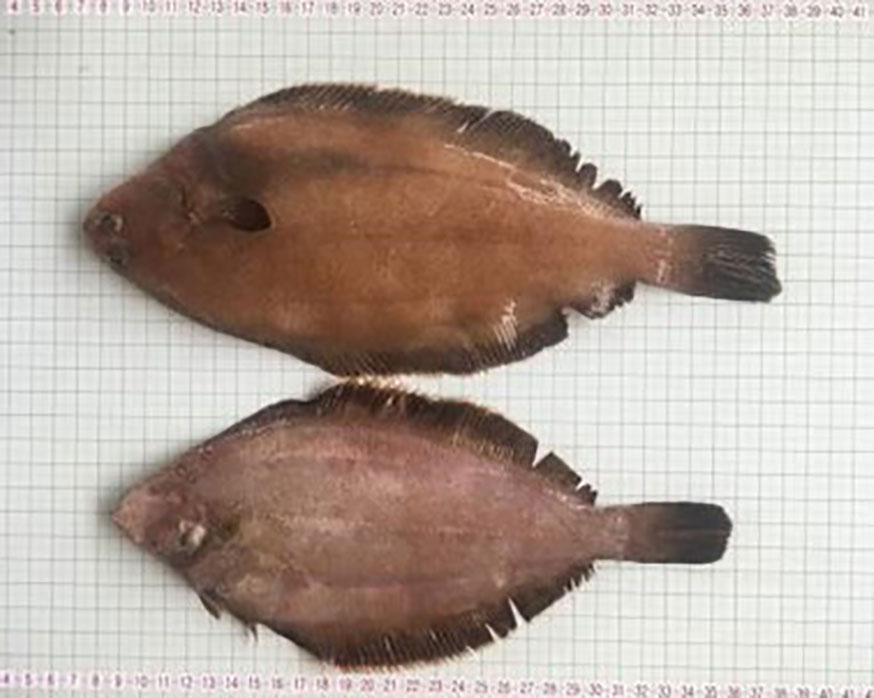
Figure 1 Blackfin flounder (Glyptocephalus stelleri, Figure 1) were selected as the target fish for this study.
Flounder, the main target species of gillnets off the east coast of Korea, sometimes entangle in a gillnet their gills caught in gillnets; however, because they have flat, wide bodies, they do not entangle a gillnet completely and often fall into the sea when the net is hoisted up with a hauler. Trammel nets are similar to regular gillnets but are made up of three layers of netting. Fishermen consistently demand permission to use trammel nets that show better fishing performance since they catch a high proportion of live fish when compared to single gillnets. However, the use of trammel nets is prohibited by the Fisheries Act in Korea because of their tendency to lead to bycatch and their high catch rate of immature fishes. Recently, fishermen have been using tie-down gillnets as an alternative to trammel nets, where strings are vertically tied to a single gillnet at regular intervals and the net’s original deployment height is reduced to create a large pocket similar to a trammel gillnet (Kim et al., 2021). Tie-down gillnets are known to catch more flounder than single gillnets, however, there are not many systematic studies of tie-down gillnets. Few studies has been carried out abroad to reduce the bycatch. The research of flounder fishery in the United States showed that gillnets with lower height reduced the bycatch of Atlantic cod (Gadus morhua) while maintaining comparable catch of flounders. In blackfin flounder fishery, tie-down gillnet with different mesh sizes could be reduce the bycatch of the immature flounders and the research on mesh size selectivity in trammel nets were conducted for 17 species in the Atlantic oceans; however, their performance is unclear while further studies are still needed in different areas and methods (An et al., 2003; He, 2006; Park and Bae, 2017; KOSIS, 2020). Recently, researches were conducted on selectivity as a function of different mesh sizes (Cho et al., 2000; Park et al., 2003; Haas, 2010). It was reported that the fishing performance of gillnets varies depending on the stretched height of the net between the float line and the foot rope, mesh size selectivity and that the shape of gillnets (e.g. trammel nets vs. single gillnets) makes differences in fishing performance (Cho et al., 2000; Kim and Lee, 2002; Fabi et al., 2002; Erzini et al., 2006; He, 2006).
In this study, it was quantitatively compared the fishing performance of three types of gillnets (trammel nets, tie-down gillnets, and single gillnets), using blackfin flounder inhabiting the waters off the eastern coast of Korea as the target fish. We use the results of this study to clarify the fishing performance of each type of gillnet and establish a plan for the efficient and sustainable use of blackfin flounder, which is considered as one of the fisheries resource recovery species in Korea.
2 Materials and methods
2.1 Gillnets
The trammel nets, tie-down gillnets, and single gillnets used in this study were manufactured to have the same mesh size as that of the blackfin flounder nets used in Yangyang, Gangwon-do, Korea. The trammel nets (Figure 2A) and the tie-down gillnets (Figure 2B) were produced in the same way as commercial nets with a height of 3.07 m. In addition, in consideration of the vertical development and the shape of the mesh, a single gillnet (Figure 2C, unmodified gillnet) was manufactured to have a height of 4.2 m, the same as that of commercial nets.
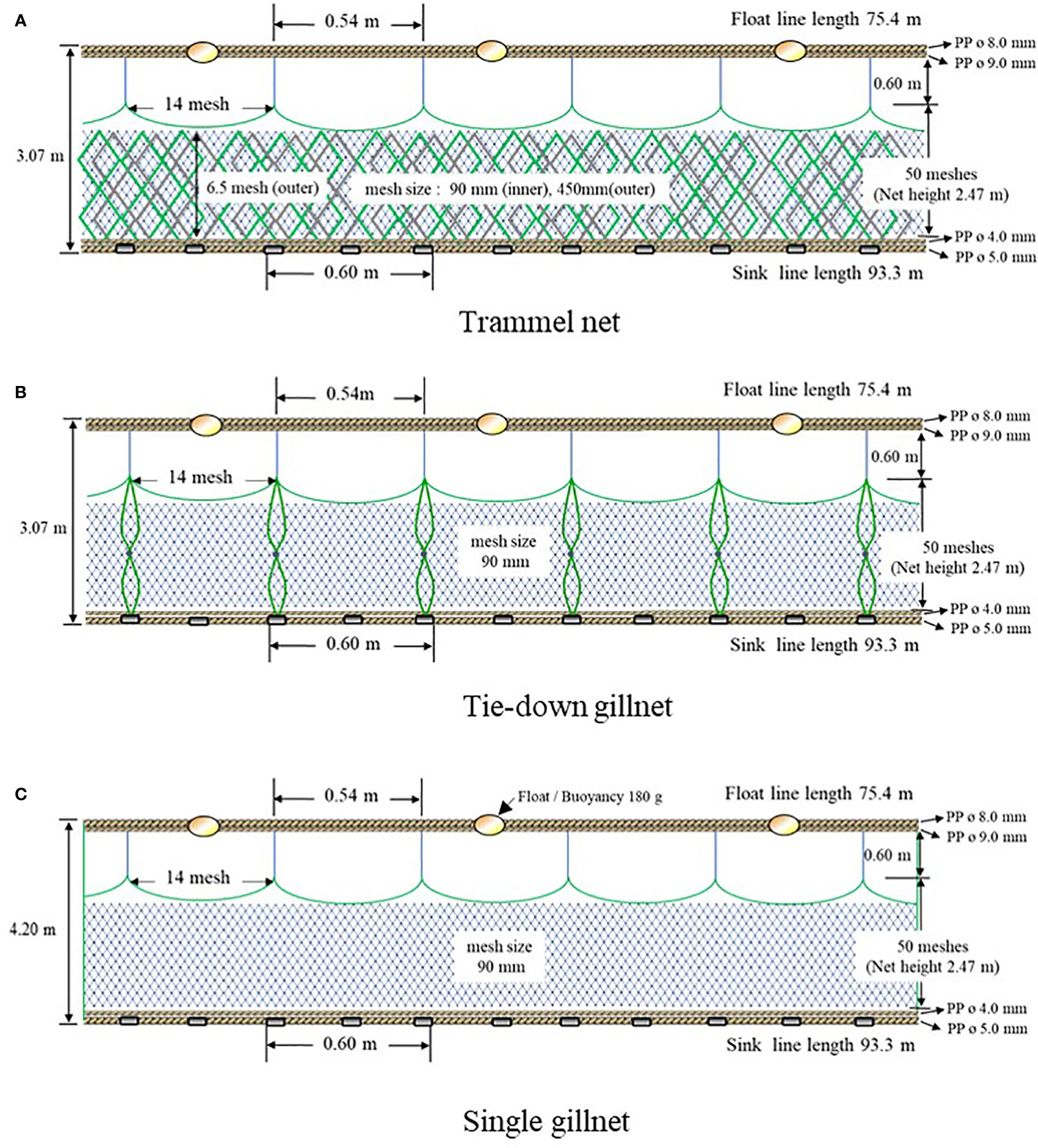
Figure 2 Construction of the experimental gillnets for blackfin flounder used in the sea trials; (A) trammel net, (B) tie-down gillnet, and (C) single gillnet.
For the trammel net, its inner net was the same as that of a single gillnet, and the nylon net (mesh size 450 mm, height 6.5 meshes, 12 braids) was used for its outer net. The ratio of the stretched height of the outer net (6.5 meshes × 450 mm) to the stretched height of the inner net (50 meshes × 90 mm) was 0.65.
The height of the support line in the tie-down gillnets was 2.47 m, and the ratio of the vertical direction of the mesh to the height of the support line was about 55%. The polyethylene support line’s diameter was Ø 1.4 mm; its two strands were vertically lowered from the float line to the foot line, and the middle part of the support line was tied to the mesh once. The length of the float line of all nets was manufactured to be 75.4 m and the length of the sinker line 93.3 m. Nets were made of nylon, and the monofilament diameter of the twine was Ø 0.286 mm. The inner diameter of the nets was measured 20 times as a proxy for its mesh size, and the average value was 90.2 ± 4 mm. The design specification of all nets is shown in Table 1, and their basic structures in accordance with the types of gillnet are shown in Figure 2.
Three gillnets were sequentially and repeatedly arranged four times, and 12 panels were configured as one set were used in each field experiment. The distance between different gillnets was approximately 1.5 meters. A typical arrangement of the test nets is shown in Figure 3. The experimental fishing gears are deployed from inshore to offshore at the depth range between 100 m and 140 m.
2.2 Sea trials
A total of eight sea trials were conducted between February 2020 and December 2020 by chartering a coastal gillnet fishing vessel (Gross tonnage: 3.90 ton, Engine propulsion: 268.4 kW) in the waters surrounding Yangyang-gun in Gangwon-do. The single trial took two days. The deployment of the net was conducted at 4:00 AM following the departure of the fishing vessel, and the hauling net was carried out at the same time the next day. Nets were immersed for one day, and the depth of fishing was about 100–140m. The experimental fishing operation location is shown in Figure 4. The catches were screened for all fish. The catches were separated by net type, classified by fish species, and then measured. The length of each fish caught was measured in millimeters on the measuring board and their weight was measured in grams using an electronic scale (CAS SW-1, Korea) to compare and analyze the catch performance of each net. In addition, the catch performance of each net was evaluated using the commercial statistical software IBM SPSS Statistics 27 (IBM, U.S.A.). Kolomogorov-Smirnov tests were used to test the normality. One-way ANOVA (Analysis of Variance) was applied to identify the differences between the control and experimental gillnets’ catch in weight. The used data were the sums of the single gillnet and experimental gillnets; trammel net and tie-down gillnet in each fleet. Comparisons were made among gear types. The catch in weight was considered count data and was calculated from the catch weight of blackfin flounder by gillnet types. CPUE (Catch Per Unit Effort) was calculated by divided the pooled catch weight of target species into the number of panels used; g/panel.
3 Results
A total of eight trials were deployed using experimental gillnets and compared their catches. Four sets of the nets were deployed. Each set consisted of three nets; one single gillnet, one tie-down gillnet, and one trammel net. We captured 2,842 (415,474 g) total fishes of 20 difference species. Among them, blackfin flounder were the highest catch (1,627; 186,503 g), which accounted for 44.9% of the total catch. Black edged sculpin (Gymnocanthus herzensteini) showed the second highest catch rate (11.7%), and whip sculpin (Gymnocanthus intermedius) the third highest catch rate (11.5%). The catches and catch rates for each net are shown in Table 2.
Trammel nets showed the highest catch with a total of 1,395 fish (187,621 g), followed by tie-down gillnets with a total of 979 fish (151,258 g), and lastly single gillnets with a total of 468 fish (76,595 g). The fishing performance among the three types of gillnets showed significant differences in a statistical test. From the one way ANOVA test, the catch of blackfin flounder has significant difference (Kolomogorov-Smirnov test, df=8, p = 0.236>0.05; one way ANOVA test, df=2, p = 0.0001<0.05). There was no significant difference between trammel net and tied-down gillnet (Tukey HSD test, p = 0.977>0.05), tie-down gillnet and single gillnet (Tukey HSD test, p = 0.052>0.05). However, there was a significant difference between trammel net and tie-down gillnet (Tukey HSD test, p = 0.036<0.05). The test with total length less than 20 centimeters, prohibited length of blackfin flounder, there was a significant difference in weight caught among the gear types (Kolomogorov-Smirnov test, df=8, p > 0.05; one way ANOVA test, df=2, p = 0.001<0.05). There was no significant difference between trammel net and tie-down gillnet (Tukey HSD test, p = 0.457>0.05). On the other hand, there was a significant difference both trammel net ((Tukey HSD test, p = 0.01<0.05) and tie-down gillnet (Tukey HSD test, p = 0.02<0.05) to the single gillnet.
The catch results for the main fish species of this study, flounder, showed the highest catch with trammel nets (886 fish; 103,963 g), followed by tie-down gillnets (538 fish; 60,575 g) and single gillnets (203 fish; 21,965 g) being the poorest performer. The catch per unit effort (CPUE) was 3,248.8 g/panel for trammel nets, 1,893.0 g/panel for tie-down gillnets, and 686.4 g/panel for single gillnets.
It was found that the blackfin flounder caught by trammel nets were relatively diverse in size (Table 3; Figure 5). In addition, although fish under 200 mm in length were not caught in large numbers, which is currently prohibited by the law, the three types of gillnets did not show statistically significant differences in catch numbers for such fish (trammel nets, 28; tie-down gillnets, 8; single gillnets, 7). In terms of bycatch rate on immature blackfin flounder less than 20 centimeters in total length, tie-down gillnet was similar to single gillnet as 20% and 17.5% respectively. However, the bycatch rate of trammel net was 62.5% (Table 3).
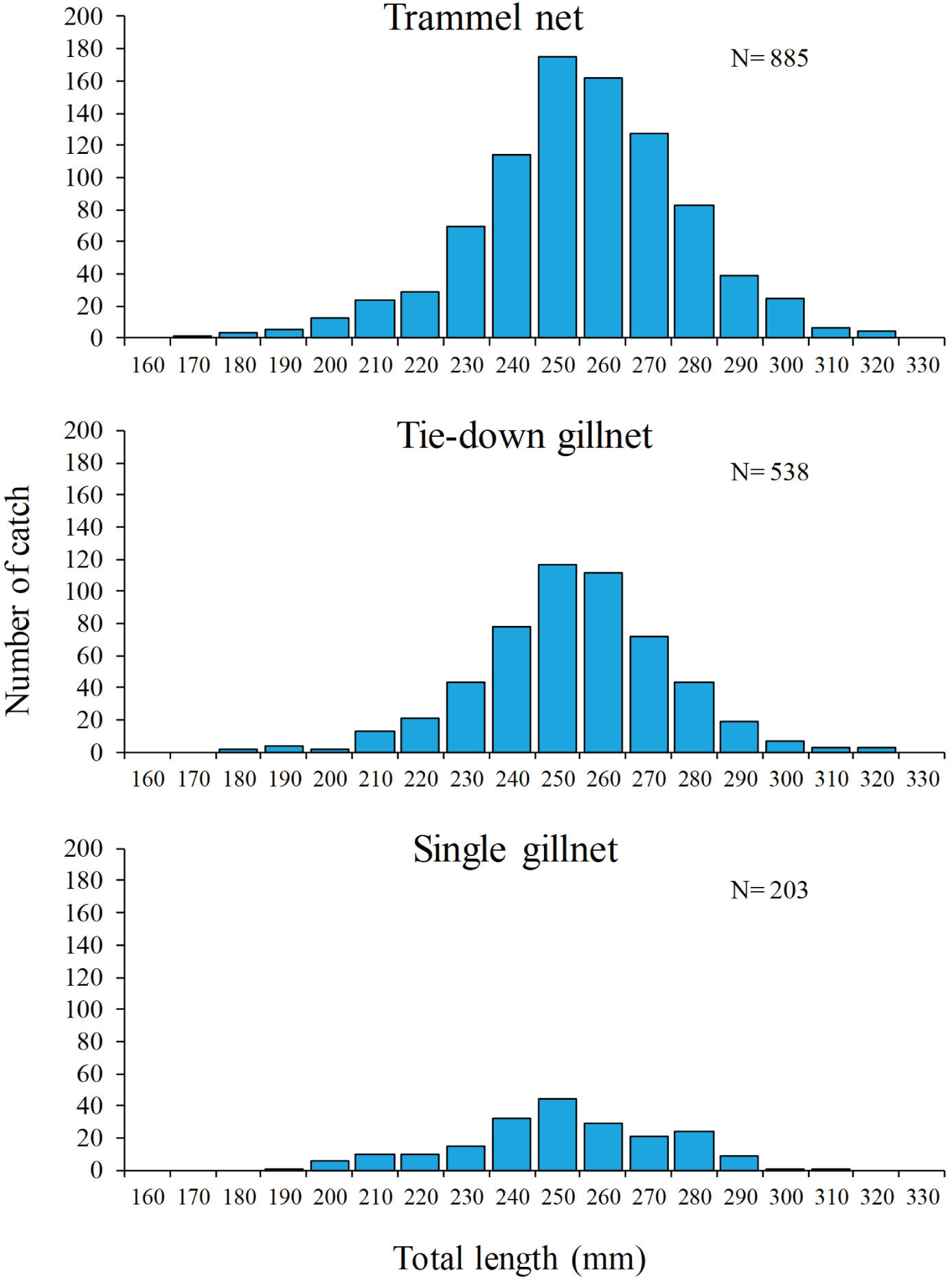
Figure 5 The distribution of the number of blackfin flounder caught in three types of gillnets as a function of their total length.
The number and distribution of blackfin flounder, the target species of this study, caught by each net was different in accordance with the gillnet types (Table 3). Total length distributions of the flounder was similar in all three net (Figure 5). When the fishing performance of single gillnets is set as 1, trammel nets performed 4.36 times better in terms of the number of blackfin flounder caught, and 4.73 times better in terms of the total weight of blackfin flounder caught, when compared to single gillnets. In addition, it was found that the tie-down gillnet, which is an intermediate type between the trammel net and the single gillnet, shows higher fishing performance by 2.65 times (the number of blackfin flounder caught) and 2.76 times (the total weight of blackfin flounder caught), when compared to the single gillnet. Therefore, the fishing performance of gillnets for blackfin flounder was shown to be in the following order: trammel nets > tie-down gillnets > single gillnets. In addition, when comparing the total catch including other species, trammel nets performed better by 2.98 times and 2.45 times in terms of the number and weight of the fish caught, respectively, and tie-down gillnets performed better by 2.09 times and 1.97 times, respectively, when compared to single gillnets (Table 4).

Table 4 The relative fishing performance of three types of gillnets, based on the catch number or weight of blackfin flounder and total catch.
Crabs are liable to get caught in gillnets by their claws or feet. During the experimental fishing period, the catch rate was 10.4% for the snow crabs and 4.1% was the female snow crabs among them, the catch of which is prohibited all year round in Korea. 6.3% was for male snow crabs. In our study, trammel nets showed 20 times higher bycatch numbers than that of single gillnets, regardless of the sex of the crabs caught; tie-down gillnets also showed about 10 times higher bycatch numbers than that of single gillnets (Figures 6, 7). Different types of nets showed the following order of performance in terms of bycatch of snow crabs: trammel nets > tie-down gillnets > single gillnets. Nets that have pockets showed higher bycatch rate than single gillnets in terms of bycatch.

Figure 6 The distribution of the number of snow crabs caught in three different gillnets as a function of their carapace length.
4 Discussion
The number of commercial fish species appearing off the east coast of Korea is limited. Among the fish species that can be caught year round, blackfin flounder are abundant and an important source of income for fishermen. Flounder often were mostly caught by gillnets in coastal areas and by trawls offshore. In the past, single gillnets were mainly used in the fishing industry, but they were dropped out during the hauling process without landing properly, resulting in frequent loss of catches. Because of this problem, some fishermen mainly used trammel nets that consist of three layers of nets. However, the use of trammel nets is now prohibited by the law, as they contribute to bycatch. According to reports, trammel nets show 1.4 to 2 times higher fishing performance than single gillnets (Kitahara, 1968; Fujimori et al., 1996; Akiyama et al., 2004; He, 2006; Wakayama et al., 2006). Recently, tie-down gillnets, an intermediate between the trammel net and the single gillnet, have been widely used to create pockets in the netting by reducing the height of the gillnet. However, it is known that there is a risk of overfishing and bycatch because tie-down nets also act like trammel nets because of their pockets; however, detailed research on their performance is still lacking (Ishida, 1962; Millar and Fryer, 1999; Kim and Lee, 2002; López-Barrera et al., 2012). Tie-down gillnets have recently attracted a lot of attention due to their increased usage, so studies on fishing performance and mesh size selectivity are being conducted (Kim et al., 2021).
According to recent regulations related to the protection of fisheries resources, the minimum landing length for blackfin flounder, a major fish species in the East Sea, is strictly implemented as a means of resource management. From this point of view, we sought to quantitatively evaluate the fishing performance of trammel nets, tie-down gillnets, and single gillnets used to catch flounder so as to obtain data that can be used to efficiently manage fisheries and limit fishing gears in consideration of their fishing performance (Baranov, 1914; Thomas et al., 2003; Kim et al., 2021).
The results showed that trammel nets performed up to 4 times better than single gillnets. In the blackfin flounder catch, trammel nets was relatively diverse in size distribution. In addition, although fish under 200 mm in length were not caught in large numbers, which is currently prohibited by the law, the three types of gillnets did not show statistically significant differences in catch numbers for such fish (trammel nets, 28; tie-down gillnets, 8; single gillnets, 7). In terms of bycatch rate on immature blackfin flounder less than 200 mm in total length, tie-down gillnet was similar to single gillnet as 20% and 17.5% respectively. In particular, fishing of snow crabs is prohibited in the East Sea during the certain period, from June 31 to November 31, where snow crabs are more strictly managed than flounder including the spawning season; fishing of male snow crabs with a length of less than 90 mm is forbidden during the fishing season, and fishing of female snow crabs is prohibited year round. In our experiment, not only flounder, but also a significant number of snow crab were caught, and among them, the trammel nets caught more male and female snow crabs when compared to the single gillnets.
The results of this study therefore suggest that it is necessary to limit and manage the use of trammel nets for the efficient use of resources and the management of prohibited fish species. The tie-down gillnet can serve as a compromise between ensuring profitability for fishermen and the government’s fisheries resource management, thus contributing to a sustainable fishing industry.
We think that the shape of each type of net investigated in this study changes differently in underwater currents. In particular, trammel nets and tie-down gillnets are expected to form pockets from two sheets of the outer nets and support lines, respectively, as shown in Figure 8. We speculate that these pockets play a role in enclosing or entangling fish in a net rather than the fish getting their gills stuck in the net, which is the unique fishing mechanism of gillnets. It can be inferred that this shape of net may contribute to high fishing performance and the fishing of individuals of various sizes.
5 Conclusions
In this study, the fishing performance of three types of gillnets was compared—trammel nets, tie-down gillnets, and single gillnets—that are used to catch blackfin flounder in the East Sea of Korea. A total of eight cruises were performed at depths of 100–140 m in the waters near Yangyang, Gangwon-do, Korea. The results showed that, when compared to single gillnets, trammel nets performed better by 2.98 times and 2.45 times, in terms of the total number and weight of fish caught, respectively, and tie-down gillnets performed better by 2.09 times and 1.97 times, respectively. We found that tie-down gillnets have an intermediate fishing performance between single gillnets and trammel nets. In addition, when the main target, blackfin flounder, was used as a standard, trammel nets showed higher fishing performance by 4.46 times (number of fish caught) and 4.73 (weight of fish caught), while tie-down gillnets showed higher fishing performance by 2.65 times (number of fish caught) and 2.76 times (weight of fish caught). Many instances were recorded of flounder being caught and then dropped out of the single gillnets. In addition, as for the bycatch of snow crab, a major commercial species off of the east coast, trammel nets showed 10 times higher number and weight of snow crabs caught when compared to single gillnets. Snow crab is a species that is heavily regulated for fisheries resource management, having both a closure and a ban on the capture of small individuals.
The use of trammel nets is currently prohibited due to their high fishing intensity. However, fishermen would like to use trammel nets because many flat fishes, like flounder, fall out of single gillnets. Given that our results show that trammel nets have better fishing performance and higher fishing rates of non-target fish and small individuals when compared to single gillnets, we conclude that restrictions are indeed required for the use of trammel nets. In addition, flounder, including blackfin flounder, have recently been intensely regulated under a law that imposes a prohibited length in an effort to protect fisheries resources. From this point of view, it is necessary to closely evaluate different types of nets to ensure the efficient use and fisheries management of resources. In terms of flounder fishing off of the east coast, tie-down gillnets show better fishing performance than single gillnets and are more effective in reducing bycatch of non-target fish than trammel nets. In this regard, one solution can be to optimize the tie-down gillnet through meetings between stakeholders as a sustainable fishing gear. However, further researches on tie-down gillnets are also required to quantitate the fishing performance in accordance with the tie-down length, thickness of tie-down, tie-down composition for the sustainable use of the gillnet. Taken together, we envision that this study can be used as basic data in the design of nets to effectively manage the fishing of flounder that also secures the livelihood of fishermen.
Data availability statement
The original contributions presented in the study are included in the article/supplementary material. Further inquiries can be directed to the corresponding author.
Author contributions
SK conceived and designed the experiments, analyzed the data, prepared the experiments, authored and reviewed drafts of the paper, and approved the final draft. HK contributed to the experimental design and supervision, provided editorial reviews of the manuscript, and approved the final draft. PK conceived and performed the experiments, analyzed the data, authored and reviewed drafts of the paper, and approved the final draft. All authors contributed to the article and approved the submitted version.
Funding
This study was conducted with the support of the Fisheries Research Project (R2023042) of the National Institute of Fisheries Science of Korea and the Ministry of Oceans and Fisheries of Korea.
Acknowledgments
This study was carried out with the support of the Fisheries Research Project (R2023042) of the National Institute of Fisheries Science, Korea. The authors are also grateful to the Ministry of Oceans and Fisheries, Korea. They would like to thank Jongnam Lee, captain of fishing vessel Gieun, and his crew for their help and assistance onboard the vessel. They also thank Dr. Chang-Doo Park for his thoughtful comments.
Conflict of interest
The authors declare that the research was conducted in the absence of any commercial or financial relationships that could be construed as a potential conflict of interest.
Publisher’s note
All claims expressed in this article are solely those of the authors and do not necessarily represent those of their affiliated organizations, or those of the publisher, the editors and the reviewers. Any product that may be evaluated in this article, or claim that may be made by its manufacturer, is not guaranteed or endorsed by the publisher.
References
Akiyama S., Kaihara S., Arimoto T., Tokai T. (2004). Size selectivity of a trammel net for oval squid Sepioteuthis lessoniana. Fish. Sci. 70, 945–951. doi: 10.1111/j.1444-2906.2004.00893.x
An H. C., Bae J. H., Kim S. (2003). Study on the size selectivity of a gillnet for pacific herring (Clupea pallasii) in the eastern sea of Korea. J. Kor. Soc Fish. Technol. 49, 360−367. doi: 10.3796/KSFT.2013.49.4.360
Cho Y. B., Park C. D., Lee J. H. (2000). A study on the selectivity of the mesh size in trammel net for Cynoglossidae spp. Bull. Kor. Soc Fish. Tech. 36, 89–95.
Erzini K., Gonçalves J. M. S., Bentes L., Moutopoulos D. K., Hernando Casal J. A., Soriguer M. C., et al. (2006). Size selectivity of trammel nets in southern European small-scale fisheries. Fish. Res. 79, 183–201. doi: 10.1016/j.fishres.2006.03.004
Fabi G., Sbrana M., Biagi F., Grati F., Leonori I., Sartor P. (2002). Trammel net and gill net selectivity for Lithognathus mormyrus (L., 1758), Diplodus annularis (L., 1758) and Mullus barbatus (L., 1758) in the Adriatic and ligurian seas. Fish. Res. 54, 375–388. doi: 10.1016/S0165-7836(01)00270-3
Fujimori Y., Tokai T., Hiyama S., Matuda K. (1996). Selectivity and gear efficiency of trammel nets for kuruma prawn (Penaeus japonicus). Fish. Res. 26, 113–124. doi: 10.1016/0165-7836(95)00392-4
Haas H. L. (2010). Using observed interactions between Sea turtles and commercial bottom-trawling vessels to evaluate the conservation value of trawl gear modifications. Mar. Coast. Fisheries 2, 263–276. doi: 10.1577/C09-013.1
He P. (2006). Effect of the headline height of gillnets on species selectivity in the gulf of Maine. Fish. Res. 78, 252–256. doi: 10.1016/j.fishres.2005.11.015
Kim P., Kim H., Kim S. (2021). Mesh size selectivity of tie-down gillnets for the blackfin flounder (Glyptocephalus stelleri) in Korea. Appl. Sci. 11, 9810. doi: 10.3390/app11219810
Kim S. H., Lee J. H. (2002). Mesh selectivity in trammel net for flat fish. Bull. Kor. Soc Fish. Tech. 38, 91–100. doi: 10.3796/KSFT.2002.38.2.091
Kitahara T. (1968). On sweeping trammel net (Kogisasiami) fishery along coast of the San in distric - III. mesh selectivity curve of sweeping trammel net for Branquillos. Bull. Japan. Soc Fish. Tech. 34, 759–763. doi: 10.2331/suisan.34.759
KOSIS (2020) Korean Statistical information service, fishery production survey. Available at: https://kosis.kr/eng/statisticsList/statisticsListIndex.do?menuId=M_01_01&vwcd=MT_ETITLE&parmTabId=M_01_01&statId=1970004&themaId=#SelectStatsBoxDiv (Accessed May, 2022).
López-Barrera E. A., Longo G. O., Monteiro-Filho E. L. A. (2012). Incidental capture of green turtle (Chelonia mydas) in gillnets of small-scale fisheries in the paranaguá bay, southern Brazil. Ocean Coast. Management. 60, 11–18. doi: 10.1016/j.ocecoaman.2011.12.023
Millar R. B., Fryer R. J. (1999). Estimating the size-selection curves of towed gears, traps, nets and hooks. Rev. Fish. Biol. Fish. 9, 89–116. doi: 10.1023/A:1008838220001
Park C. D., An H. C., Cho S. K., Baik C. I. (2003). Size selectivity of gill net for male snow crab, Chionoecetes opilio. J. Kor. Soc Fish. Tech. 39, 143–151. doi: 10.3796/KSFT.2009.45.2.122
Park C. D., Bae J. H. (2017). Mesh selectivity of the bottom trammel net for spinyhead sculpin Dasycottus setiger in the eastern coastal sea of Korea. J. Kor. Soc Fish. Technol. 53, 317–326. doi: 10.3796/KSFT.2017.53.4.317
Thomas S. N., Edwin L., George V. C. (2003). Catching efficiency of gill nets and trammel nets for penaeid prawns. Fish. Res. 60, 141–150. doi: 10.1016/S0165-7836(02)00057-7
Keywords: blackfin flounder, trammel net, tie-down gillnet, single gillnet, fishing performance, support line, fisheries management
Citation: Kim S, Kim H and Kim P (2023) The application of tie-down gillnet to improve the capture of blackfin flounder (Glyptocephalus stelleri) in a sustainable way. Front. Mar. Sci. 10:1034999. doi: 10.3389/fmars.2023.1034999
Received: 02 September 2022; Accepted: 03 April 2023;
Published: 14 April 2023.
Edited by:
Alessandro Lucchetti, National Research Council (CNR), ItalyReviewed by:
Jesse F. Senko, Arizona State University, United StatesWendy Piniak, National Oceanic and Atmospheric Administration (NOAA), United States
Copyright © 2023 Kim, Kim and Kim. This is an open-access article distributed under the terms of the Creative Commons Attribution License (CC BY). The use, distribution or reproduction in other forums is permitted, provided the original author(s) and the copyright owner(s) are credited and that the original publication in this journal is cited, in accordance with accepted academic practice. No use, distribution or reproduction is permitted which does not comply with these terms.
*Correspondence: Pyungkwan Kim, dHJhd2w5OEBrb3JlYS5rcg==
 Seonghun Kim
Seonghun Kim Hyungseok Kim1
Hyungseok Kim1 Pyungkwan Kim
Pyungkwan Kim
